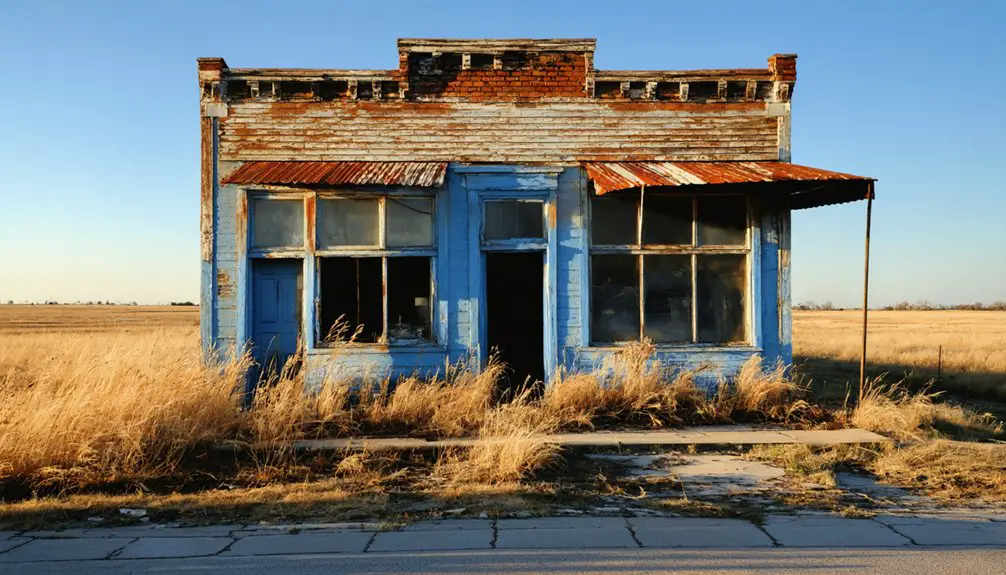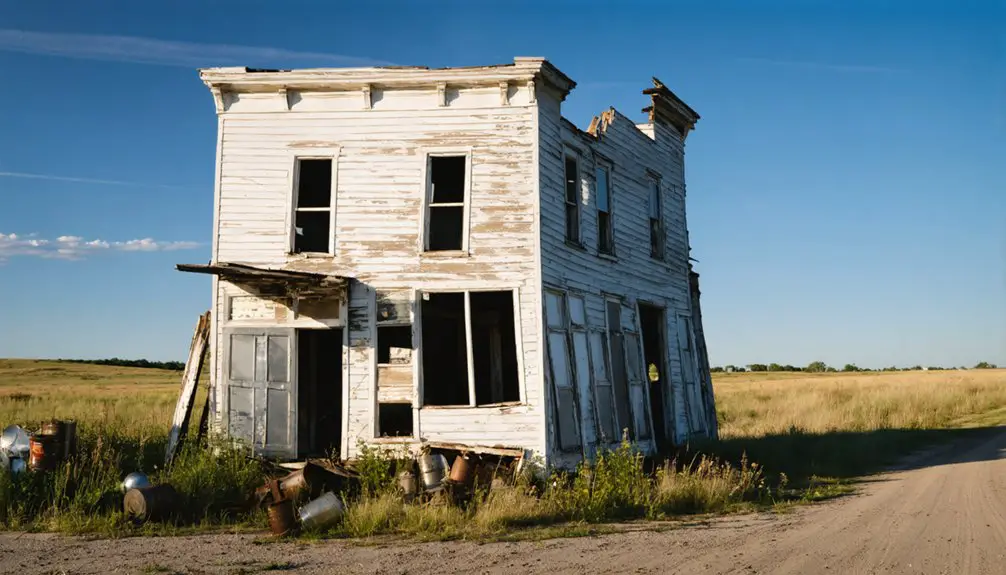You’ll find Ohio City’s story began in 1855 as a Free-state settlement during Kansas’s territorial period. The town thrived until the Great Fire of 1866 devastated the community, followed by a second major fire that forced residents to relocate. In 1870, they established Princeton one mile south and west, physically moving their homes using rollers. The post office transfer that year marked Ohio City’s official end. The town’s dramatic transformation from frontier settlement to ghost town holds fascinating details.
Key Takeaways
- Ohio City was established in 1855 by Thomas Ivy along Upper Middle Creek as a Free-state settlement during Kansas’ territorial period.
- Two devastating fires struck Ohio City, with the first in 1866 leaving 10,000 residents homeless and prompting initial rebuilding efforts.
- After the second fire, residents decided to relocate, establishing Princeton one mile south and west of Ohio City in 1870.
- The post office’s transfer to Princeton in 1870 marked Ohio City’s official administrative end and the beginning of its ghost town status.
- By 1999, Ohio City had completely vanished into rural land, with no remaining physical structures marking its original location.
Early Settlement and Establishment
As westward expansion gained momentum in the mid-19th century, Ohio City emerged from a wave of migration that brought settlers primarily from Ohio to the Kansas Territory. The earliest settler experiences began around 1855, when Thomas Ivy staked his claim along Upper Middle Creek. The Actual Settlers Association helped regulate claims and settle disputes between new arrivals in the region.
Similar to King City’s colony movement, a group of determined pioneers made their way west to establish a new settlement. You’ll find that by 1857, the area attracted large-scale immigration after the forced removal of Pottawatomie tribes opened the land for settlement.
These pioneering families, including Judge Merritt, James Carter, and Jacob Bolman, established themselves through diverse agricultural practices while living in temporary shelters like tents and wagon boxes. Their determination shaped Ohio City’s early character, with settlers taking on multiple roles as farmers, blacksmiths, and merchants.
Rise to County Seat Status
Building upon its early settlement success, Ohio City set its sights on becoming Franklin County’s administrative center in 1857. The town’s strategic location and newly established post office strengthened its bid for county seat status, as it competed against rival towns Peoria and Mt. Vernon. Like many Kansas counties established between 1855 and 1888, Franklin County needed a strong administrative hub to manage territorial governance.
In 1859, Ohio City ultimately lost the contested county seat election to Peoria.
The local economy played a vital role in Ohio City’s aspirations, though specific details remain limited.
You’ll find that the town’s determination to secure the coveted position was evident through:
- Strong community involvement and local leadership advocating for administrative hub status
- Infrastructure development aimed at supporting county-level operations
- Strategic positioning for trade and commerce to boost economic viability
Despite these efforts, Ohio City faced significant challenges in maintaining its prominence, ultimately affecting its bid for county seat designation.
The Great Fire of 1866
The devastating Great Fire of 1866 struck Ohio City during a period when the settlement’s firefighting capabilities were severely limited.
Before the blaze, you’d find only basic fire prevention measures – bucket brigades and water-soaked blankets were your main defenses against flames. The town’s first hook and ladder company wasn’t organized until February 1, 1866, leaving the community vulnerable. Ten thousand residents were left homeless after the catastrophe.
Ohio City relied on primitive firefighting methods like bucket brigades, with no formal fire department until early 1866.
While exact casualty figures aren’t recorded, the fire’s economic impact was significant enough to prompt swift action. The disaster occurred as Fort Atkinson had already been abandoned due to poor conditions.
You’ll notice the response in the following year – the Harmony Fire Company formed in October 1867, and they purchased their first fire engine the next month.
The disaster likely contributed to Ohio City’s eventual ghost town status, as the frontier settlement struggled to recover from such widespread destruction.
Rebuilding Efforts and Community Spirit
Following the devastating 1866 fire, Ohio City’s residents displayed remarkable resilience by launching into immediate reconstruction efforts.
You’ll find that the community’s collective memory of this period highlights extraordinary cooperation, with neighbors helping neighbors rebuild their homes and businesses. This community resilience became even more evident when a second fire struck, yet the townspeople’s determination remained unshaken. Much like Garnet, Montana’s own devastating fire in 1912, Ohio City faced similar challenges in rebuilding from the ashes.
Key aspects of Ohio City’s rebuilding phase included:
- Shared labor and resources among residents
- Maintenance of essential institutions like the post office until 1870
- Strategic planning that eventually led to relocation
The rebuilding efforts weren’t just about physical structures – they fostered deep social bonds that would later prove significant when the community decided to relocate and rebrand as Princeton, about a mile south and west of the original site. Due to frequent confusion with other locations, historians often use place name disambiguation to distinguish this Ohio City from others in different states.
Second Fire and Town Relocation
Despite surviving the devastating 1866 fire, Ohio City faced another significant setback when a second major fire struck the settlement at an unspecified date.
Like many Kansas settlements facing natural disasters similar to grasshopper invasions in Irving, Ohio City struggled to maintain its population through multiple catastrophes.
Natural disasters, particularly during this era, often spelled doom for frontier towns as economic downturns made recovery nearly impossible.
In the fire aftermath, the struggling community had to confront the harsh reality of rebuilding once again, stretching their already limited resources.
The community’s resilience was tested as they weighed their options. Rather than attempting another rebuild, you’ll find that the townspeople made the pivotal decision to relocate.
They established a new settlement called Princeton, situated one mile south and west of Ohio City. The post office, which had served Ohio City since 1857, officially moved to Princeton in 1870, marking the end of Ohio City’s role as an independent frontier settlement.
Transformation Into Princeton
After a series of setbacks including fires, you’ll find that Ohio City’s community leaders made the strategic choice to relocate near the Leavenworth, Lawrence & Galveston Railroad siding in 1869.
E.M. Peck, a prominent settler, named the new location “Princeton” after his Illinois hometown when establishing the railroad delivery point.
The transformation became complete in 1870 when Thompson Jones donated land along the tracks, leading to Princeton’s official establishment and Ohio City residents moving their homes and businesses to the new site.
Relocation After Second Fire
When Ohio City endured its second devastating fire in the late 1860s, the community made the strategic decision to relocate rather than rebuild at the original site.
You’ll find that this fire recovery effort led to a complete resident migration approximately one mile south and west of the original location, establishing what would become Princeton in 1870.
- E.M. Peck named the new settlement after his hometown of Princeton, Illinois
- Thompson Jones donated land for the formal town layout and street planning
- The LL&G Railroad siding proved essential for the new location’s success
The move was thorough, with families physically relocating their homes using rollers, while vital services quickly followed.
The post office transfer in 1870 marked the official transformation, and by 1872, new churches and businesses were flourishing in Princeton‘s more strategic location.
Community Leadership’s Strategic Move
The community leaders of Ohio City demonstrated remarkable foresight in orchestrating their town’s strategic change into Princeton during 1869-1870.
You’ll find their leadership decisions centered on securing a vital railroad connection when E.M. Peck negotiated with the Leavenworth, Lawrence & Galveston Railroad to establish a siding.
Thompson Jones’s donation of land parallel to the tracks proved critical to the community dynamics, enabling formal town planning with defined streets and boundaries.
The change’s success is evident in how families physically moved their homes to Princeton, while institutional transfers – like the post office’s relocation under Thomas Fletcher’s management – maintained essential services.
The swift establishment of School District #63 and religious institutions between 1872-1886 further solidified Princeton’s emergence as a thriving community.
Legacy Through Name Change
During Ohio City’s pivotal transformation in 1869-1870, E.M. Peck chose “Princeton” as the new name for the railroad siding, drawing from his Illinois hometown. This name change would come to symbolize more than just a geographical shift – it marked the birth of a new community identity.
You’ll find that as Ohio City’s residents physically moved their homes and businesses to Princeton, they weren’t just relocating; they were embracing a fresh start.
- The transfer of the post office equipment in 1870 officially marked Princeton’s establishment
- Religious institutions, including Methodist (1872) and Presbyterian (1880) churches, reinforced the new identity
- School District #63’s creation in 1869 cemented Princeton’s foundation as a permanent settlement
The name significance resonated deeply, as Princeton grew into a thriving railroad hub while Ohio City faded into memory.
Life in 19th Century Ohio City
Life in Ohio City during the 1850s centered around an ambitious Free-state settlement that drew diverse pioneers from Pennsylvania and other northern states seeking to establish an anti-slavery foothold in Kansas Territory.
You’d have found yourself among settlers like D.C. Ault and Captain S.B. Todd, working to build a community driven by democratic ideals and agricultural prosperity.
Daily routines revolved around farming practices tied to seasonal rhythms, from spring planting to fall harvest.
You’d have participated in social gatherings that strengthened community bonds, often centered around religious services and community barn-raisings.
The settlement’s wooden structures and organized grid pattern reflected New England village designs, while shared labor and mutual support helped pioneers overcome harsh weather, limited medical care, and regional political tensions.
Legacy and Final Remnants

While Ohio City’s early settlers built a vibrant community, their ambitious dreams began to unravel in 1866 when a devastating fire swept through the settlement.
Though residents showed remarkable resilience by rebuilding, a second fire ultimately led to the town’s economic impact shifting to Princeton, located one mile south and west.
The cultural significance of Ohio City lives on through these key developments:
- Post office relocation to Princeton in 1870 marked the official administrative change
- Complete physical erasure by 1999 transformed the site into indistinguishable rural land
- Historical documentation preserves Ohio City’s legacy in regional archives and databases
You’ll find no visible remnants of Ohio City today, but its story reflects the challenging realities of 19th-century frontier life, where communities often faced destruction, relocation, and reinvention to survive.
Frequently Asked Questions
Were Any Notable Artifacts Recovered From Ohio City Before Its Final Demolition?
You’ll find artifact discoveries included metal belt buckles, decorative knobs, old coins, and domestic silverware pieces. These hold historical significance in showing daily life before the town’s final demolition.
What Native American Tribes Originally Inhabited the Area Before Ohio City’s Establishment?
You’ll find rich Native Tribes’ cultural heritage in the area, with the Kansa (Kaw) and Osage peoples living there first, followed by the displaced Wyandot tribe’s arrival in the 1840s.
Did Ohio City Have a School System During Its Peak Years?
You’ll find limited evidence of Ohio City’s own school system, though its residents likely accessed educational facilities within the broader Wyandotte County network that emerged after the 1886 consolidation of regional schools.
What Was the Primary Economic Activity or Industry in Ohio City?
While you might expect grand industries, basic farming practices dominated the local economy until fires forced relocations in 1866. You’ll find no evidence of major manufacturing or specialized industry before its decline.
How Many Residents Chose to Relocate to Princeton Versus Moving Elsewhere?
You can’t determine exact relocation patterns from available population statistics. While Princeton’s establishment in 1870 suggests local migration, there’s no historical data showing how many Ohio City residents specifically moved there.
References
- https://en.wikipedia.org/wiki/Ohio_City
- https://www.youtube.com/watch?v=iB5rHT14eVI
- https://www.youtube.com/watch?v=alC1wDdSVvg
- https://www.youtube.com/watch?v=OyBXD18P_j4
- https://freepages.rootsweb.com/~gtusa/history/usa/ks.htm
- https://legendsofkansas.com/king-city-kansas/
- http://www.ksgenweb.org/archives/1918ks/v1/ch18p1.html
- http://www.kancoll.org/books/cutler/franklin/franklin-co-p2.html
- https://en.wikipedia.org/wiki/History_of_Ohio
- https://ohioauditor.gov/publications/docs/AlongTheOhioTrail.pdf



